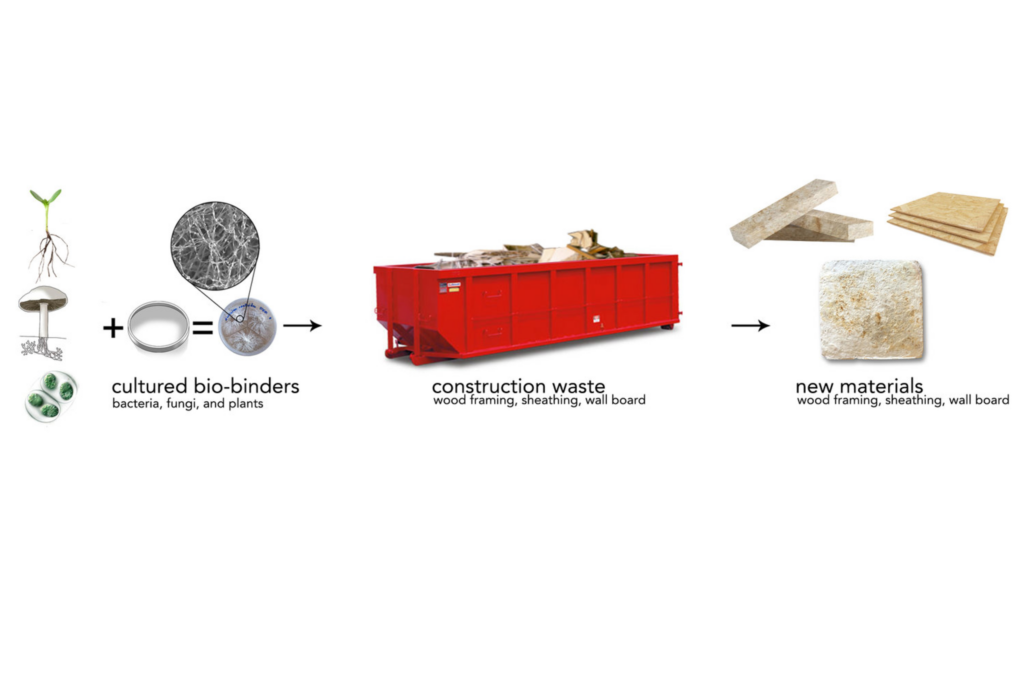A Cleveland architecture firm is leveraging the magic of mushrooms to turn building debris into clean, new “bio-bricks” that can become new structures.
In Cleveland, Ohio, where derelict buildings are all too often contaminated with lead paint and landfilled at the end of their use, an architecture firm is working with an unlikely suspect to grind up the contaminated debris, rid it of its lead, and transform it into new construction material. The suspect? Fungi.
Redhouse Studio, driven by the visionary approach of architect, researcher, and educator Christopher Maurer and his team, is leveraging a new technology to address the critical issue of deserted, lead-poisoned infrastructure, though the technology can also be applied to a wide range of other debris. And they’re doing it in a way that’s, well … not quite mainstream.
Using mushrooms in a process called mycoremediation, their technology is able to transform blighted buildings into bio-bricks composed entirely of decontaminated construction waste, not only diverting material from landfills, but also paving the way for net-zero and carbon-negative homes through creating a blueprint of zero-emission construction.
In partnership with Johns Hopkins and Case Western Reserve, Redhouse Studio is conducting lab-scale studies and remediation research to refine and validate this technology.
Understanding Mycoremediation
Mycoremediation is a process that employs fungi to decontaminate the environment. Mycelium—the root-like structures that exist beneath the fruiting mushroom we all know — binds with construction and demolition waste at a cellular level to degrade and sequester pollutants, in this case … lead.
The result is a “bio binder” material: the binding of the mycelium filaments, known as hyphae, with the woody, organic substrate. This can then be combined with natural glue or cement to create new, structural, insulated, fire-resistant, and sound absorbent biobricks to use as construction material.
Because mushrooms can absorb contaminants and toxins such as lead, they’re the perfect candidates to convert construction waste into useful building materials. Mycoremediation is particularly relevant for cities like Cleveland, where children are exposed to lead at around four times the national average, and the city’s air quality is the ninth worst in the nation, according to a report from the American Lung Association.
The Bio-brick Revolution
The environmentally clean bricks resemble wood blocks in their look and feel and measure 6 x 9 x 3 inches, a standard size for building materials, demonstrating that sustainable building materials can align with conventional construction standards. They are integral to Redhouse Studio's commitment to “biocycling,” a process that recycles old buildings into new ones using plant materials and construction waste like plywood, OSB (synthetic wood), framing, gypsum board, ceiling tiles, asphalt shingles, and other materials.

They’re all sent through the same machinery and come out as bricks that can withstand twice the pressure of concrete blocks, according to Maurer. During the mycoremediation process, materials are shredded and reconstituted by the fungi. The fungi dissolve the lignin of the wood and replace it with their own, much stronger fungal fibers — a tradeoff that Maurer says is “the best of both Kingdoms,” plant and fungal. “The ultimate goal,” he says, “is to make new buildings entirely out of old ones.”
The Scale of Impact
With over 7,000 abandoned homes tarnishing the urban landscape of Cleveland, and an estimated thirty million homes across America in need of biocycling, the potential for impact is vast, Maurer notes. Cleveland allocated $5 million just last year for the demolition of 500 vacant homes. Scaling the biocycler technology to meet this demand is a long-term endeavor, yet the rewards promise a significant reduction in the toxicity of our infrastructure and a massive decrease in post-construction waste.
When paired with a weather-proof barrier, bio-bricks have the potential to replace almost all standard construction materials, at a fraction of the cost.
– Miranda Lipton
The integration of these bio-bricks into construction projects could translate to a remarkable reduction in carbon footprint. Like wood, the bio-bricks need protection from weathering. Any weather barrier or siding that works for wood framing also works for biocycled materials, including aluminum siding, paint, concrete board, fired brick, and more.
When paired with a weather-proof barrier, bio-bricks have the potential to replace almost all standard construction materials, at a fraction of the cost. And when the weather-proof barrier is removed, the materials are fully biodegradable, ensuring a sustainable life cycle. By comparison, in the US alone, over 500 million tons of construction waste end up in landfills each year.
Challenges and Opportunities
The journey to scale biocycling and mainstream the use of biobricks faces a number of challenges — from potential resistance in the building industry to the need for long-term testing and validation. But it’s a journey worth taking, given the considerable environmental benefits bio-bricks offer, and the team at Redhouse Studio is committed to fostering a paradigm shift in construction materials.


